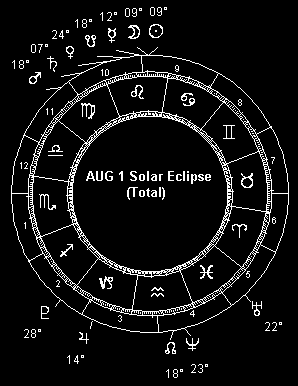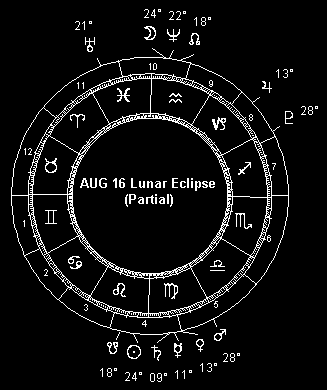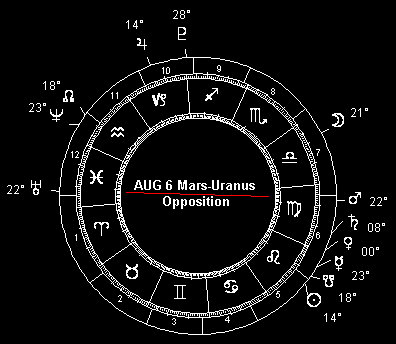If you were expecting some kind of sun sign nonsense, forget about it. This is real astrology for the real world. If it's real astrology for yourself that you want, you can get it by phone or in print. And if you need help deciphering the astrological glyphs in the graphics accompanying this article, see Astroglyphs: Astrological Symbols Guide. Please note: this forecast is expressed in terms of Universal Time (UT). Also please be aware that, while I never change a forecast once it's published, I do post errata to acknowledge typographical errors and the like.
As for the future, your task is not to foresee it, but to enable it.
-- Antoine de Saint-Exupery
 August is another big month, with its pair of eclipses, Mars-Uranus opposition and strong Neptune-lunar node connection. This may be the most intense few weeks since February, with regard to storm and seismic potential - geophysical, political and economic. There's good news too, probably around the 21st, when Mercury and Venus align. But good news takes care of itself. It's the other stuff that requires some preparation in advance, so let's get to it.
August is another big month, with its pair of eclipses, Mars-Uranus opposition and strong Neptune-lunar node connection. This may be the most intense few weeks since February, with regard to storm and seismic potential - geophysical, political and economic. There's good news too, probably around the 21st, when Mercury and Venus align. But good news takes care of itself. It's the other stuff that requires some preparation in advance, so let's get to it.
The August 1 total solar eclipse at 9° 32 Leo lies in the middle of a geophysical stress window that stretches from July 25 to August 8 ("probably peaking around July 29 as well as August 1 and 4," as noted in my 2008 World Forecast Highlights). Northeastern North America and most of Europe and Asia fall under the shadow of the eclipse, and that makes them obvious targets of the increased storm and seismic potential at work during this period. Astro-locality mapping picks up a few other possible danger zones, including a longitudinal swath through Alaska and Hawaii in the New World, and from Johannesburg up through St. Petersburg in the Old; as well as a horizon arc that sweeps across Alaska and northwest Canada down through the Great Lakes to pass over Washington DC into the Atlantic, across Hispaniola and passing over Caracas through southern Brazil. In the eastern hemisphere, this arc passes over Indonesia and the Philippines to skirt western Japan, the Korean Peninsula and Vladivostok.
Don't be lulled into a false sense of security if the solar eclipse finds you outside one of the target zones mentioned above. Eclipses are alignments of Sun, Earth and Moon; which makes them global in scope down here on our home planet. The August 1 eclipse signals a worldwide elevated risk of strong storms with high winds and heavy precipitation, plus enhanced moderate-to-severe seismic activity (magnitude 5.0 and higher earthquakes as well as volcanic eruptions). It's better to be needlessly prepared than caught off guard, for sure. Have your emergency supplies and preparations up to par, just in case.
 The August 16 partial lunar eclipse at 24° 21' Aquarius, the last eclipse of the year, brings an elevated storm and seismic risk that extends from the 13th through the 19th; probably most intense around the 16th and 19th in particular. Such risks, as always, are planet-wide. However they may be most pronounced in areas where the eclipse is visible (mainly the eastern hemisphere, although eastern South America catches a glimpse), as well as along certain astro-locality zones. These include longitudinal swaths running through the Yukon in the New World and through Russia, the Middle East and East Africa in the Old; also along horizon arcs that sweep from Buenos Aires through Iceland and down through Mongolia and China, Indonesia and Australia.
The August 16 partial lunar eclipse at 24° 21' Aquarius, the last eclipse of the year, brings an elevated storm and seismic risk that extends from the 13th through the 19th; probably most intense around the 16th and 19th in particular. Such risks, as always, are planet-wide. However they may be most pronounced in areas where the eclipse is visible (mainly the eastern hemisphere, although eastern South America catches a glimpse), as well as along certain astro-locality zones. These include longitudinal swaths running through the Yukon in the New World and through Russia, the Middle East and East Africa in the Old; also along horizon arcs that sweep from Buenos Aires through Iceland and down through Mongolia and China, Indonesia and Australia.
Economic issues are likely to be a major concern in the world around the time of this eclipse, which is conjunct Neptune at a time when there's a triple conjunction of Mercury, Venus and Saturn going on. With Neptune and the north lunar node aligning in 2008, this year's eclipses are Neptunian in nature as they slide from the Virgo-Pisces polarity into Leo-Aquarius.
 In this regard, I've already said that "February and August are the months to watch" with regard to the world financial system's lurching collapse. The solar eclipse on February 7 was conjunct Neptune, and so is the lunar eclipse on August 16. This in effect extends the 2006-2007 Saturn-Neptune opposition theme: a loss of confidence, the money's gone, misplaced faith, theft and deception (including self-deception), the Emperor has no clothes. This operates at a lot of levels, to be sure. But given what has already gone before, and the fact that we're having a Saturn-Uranus opposition this year as well, I have to think the currency crisis now underway runs into the next in a succession of major shake-downs this month. The financial wizards that run central banks and national treasuries keep pulling one rabbit after another out of their hats, but it's just one sleight-of-hand after the next. Each new adjustment is hailed by the financial pundits as the fix to the mess - until the next crisis comes along, a few weeks later. The real problem is that the system itself is fraudulent, which becomes clearer under the light of this full moon eclipse. As I've said many times, this is not one huge, dramatic crash: just another in a series of downward shudders, as the soufflé continues to settle.
In this regard, I've already said that "February and August are the months to watch" with regard to the world financial system's lurching collapse. The solar eclipse on February 7 was conjunct Neptune, and so is the lunar eclipse on August 16. This in effect extends the 2006-2007 Saturn-Neptune opposition theme: a loss of confidence, the money's gone, misplaced faith, theft and deception (including self-deception), the Emperor has no clothes. This operates at a lot of levels, to be sure. But given what has already gone before, and the fact that we're having a Saturn-Uranus opposition this year as well, I have to think the currency crisis now underway runs into the next in a succession of major shake-downs this month. The financial wizards that run central banks and national treasuries keep pulling one rabbit after another out of their hats, but it's just one sleight-of-hand after the next. Each new adjustment is hailed by the financial pundits as the fix to the mess - until the next crisis comes along, a few weeks later. The real problem is that the system itself is fraudulent, which becomes clearer under the light of this full moon eclipse. As I've said many times, this is not one huge, dramatic crash: just another in a series of downward shudders, as the soufflé continues to settle.
The August 6 Mars-Uranus opposition is another one of the year's many notable Red Planet power cycles, and it's within a few degrees of exact for a week either side of that date. Criminality, terrorism, military conflict, accidents, fires and explosion are all par for the course at times like this, so keep your eyes open, your head down and your wits about you. Bad, dangerous things can happen on any given day of course, but they tend to bunch up around strong Mars activations like this one. Heaven knows we've had a lot of them this year. I will say that this one looks like one of those "bark is worse than the bite" cases, more threat than reality, more saber-rattling than actual clashes. But given the financial focus of the month, the accidental and intentional havoc that coincide with major Mars alignments like this raise the potential for a disruption in the oil and natural gas supply chain - which in turn can shock the financial markets and put investors and institutions in a mad dash for the exits. Oil and natural gas prices have been trending downward lately, and it's a nice change for consumers. But that's a trend that can change at any time.
August ends on a strong note of storm and seismic activity, what with the new moon on the 30th following Luna's north declination peak on the 25th and perigee (closest approach to Earth) on the 26th. Look for increased storm and seismic activity the whole last week of August, continuing into early September.
 SPECIAL FEATURE: This month's birthdays of the famous and infamous (with astrological birth charts)
SPECIAL FEATURE: This month's birthdays of the famous and infamous (with astrological birth charts)